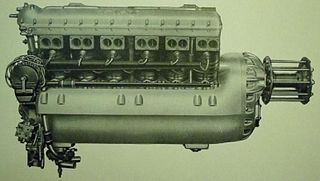
The Continental O-170 engine is the collective military designation for a family of small aircraft engines, known under the company designation of A50, A65, A75 and A80. The line was designed and built by Continental Motors commencing in the 1940s. It was employed as the powerplant for civil and military light aircraft.

The Alfa Romeo 115 was an Italian 6-cylinder air-cooled inverted inline engine for aircraft use, mainly for training and light planes, based on the de Havilland Gipsy Six engine. Production totalled approximately 1,600 units. Derivatives of the 115 include the -1, bis, ter and Alfa Romeo 116.
The Hirth HM 512 was a 12-cylinder development of the earlier, 6-cylinder HM 506, produced in the late 1930s. Both were supercharged, inverted V, air-cooled engines.

The Walter Pollux is a Czechoslovakian nine-cylinder, air-cooled, radial engine, built by Walter Aircraft Engines for powering light aircraft and that first ran in 1936. The engine produces 240 kW (320 hp) at 1,800 rpm.
One of Avia's own designs, the 1930s Avia Rk.12 was a seven-cylinder radial engine with a rated output of 150 kW (200 hp), built in Czechoslovakia.

The Avia Rk.17 was a 9-cylinder radial aircraft engine, developed from the 7-cylinder Avia Rk.12, with a rated output of 270 kW (360 hp). The Rk.17 was one of Avia's own designs and was built in Czechoslovakia in the 1930s.

The Lorraine 12H Pétrel was a French V-12 supercharged, geared piston aeroengine initially rated at 370 kW (500 hp), but later developed to give 640 kW (860 hp). It powered a variety of mostly French aircraft in the mid-1930s, several on an experimental basis.

The Asso XI was a family of water-cooled, supercharged V12 piston aeroengines produced in the 1930s by Italian manufacturer Isotta Fraschini, and fitted on a number of aircraft types built by CANT, Caproni and others.
The Train 2T, 4T and 6T were low power piston engines for light aircraft, produced in France. They were inverted, air-cooled in-line engines with the same bore and stroke, differing chiefly in the number of cylinders.
The Renault 4P, also called the Renault Bengali Junior, was a series of air-cooled 4-cylinder inverted in-line aero engines designed and built in France from 1927, which produced from 95 hp (71 kW) to 150 hp (110 kW).

The Fiat A.24 was an Italian water-cooled aircraft engine from the 1920s, built in modest numbers. It produced 520 kW (700 hp).

The Fiat A.30 R.A. was an Italian water-cooled aircraft engine from the 1920s, built in large numbers and serving with several air forces up to the beginning of World War II. It produced 447 kW (600 hp).

The Saroléa Albatros was a 22 kW (30 hp) flat twin air-cooled aircraft engine, produced just before World War II in Belgium.

The Potez 6D is a French six cylinder inverted inline aircraft engine put into production after World War II in normal and supercharged versions. Unsupercharged, it produced a take-off power of 179 kW (240 hp) at 2,530 rpm.
The Potez 8D is the largest member of the Potez D series of air-cooled piston aircraft engines which share several common features. It is a supercharged eight cylinder inverted engine with a take-off power of 373 kW (500 hp).
The Renault 6P, also called the Renault Bengali, was a series of air-cooled 6-cylinder inverted in-line aero engines designed and built in France from the late 1920s, which produced from 130 kW (180 hp) to 200 kW (270 hp).
The Ava 4A was a low power flat-four developed for very light aircraft in France in the 1930s. It was used by several prototypes and at least one production series.
The Mathis Vega 42 was a 42-cylinder 6-bank in-line radial piston engine, designed and built in France, by Société Mathis Aviation in the late 1930s, with development continuing during and after WWII.
The Hirth HM 515 was a four-cylinder air-cooled inverted inline engine, intended to power light aircraft of the 1940s. Due to World War II, demand for the light aircraft to be powered by the HM 515 dried up and only the Siebel Si 202C Hummel was powered by development engines before further work was abandoned.

The Isotta Fraschini Asso Caccia, a.k.a. Isotta Fraschini Asso-450 Caccia, was an air-cooled, supercharged V12 piston aero engine produced in the late 1920s and early 1930s by Italian manufacturer Isotta Fraschini.












